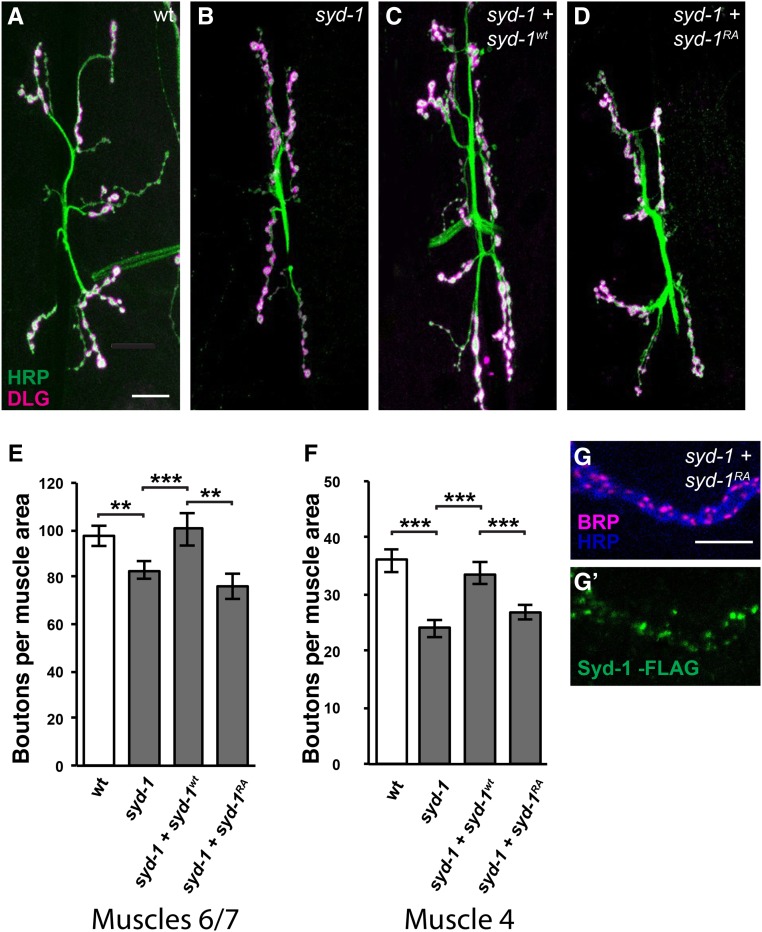Figure 4.
The decrease in NMJ bouton number in syd-1 mutants is fully rescued by wild-type Syd-1 but unaltered by R979A mutant Syd-1. (A–D) Third-instar larval NMJs at muscles 6/7 in abdominal segment 3 stained with anti-HRP (green) and anti-Dlg (magenta). Bar, 25 µm. All genotypes also contain the motorneuron driver BG380-Gal4. (A) Wild type. (B) syd-1CD/syd-1w46 mutant. (C) syd-1CD/syd-1w46 mutant in which motorneurons express wild-type Syd-1. (D) syd-1CD/syd-1w46 mutant in which motorneurons express R979A mutant Syd-1. (E) Quantification of the number of boutons on muscles 6/7 in abdominal segment 3 per muscle area. As previously reported, loss of syd-1 causes a modest but significant decrease in NMJ bouton number (BG380-Gal4 alone: 97.6 ± 4.5, n = 14; syd-1 mutant: 82.6 ± 3.7, n = 10, P = 3 × 10−3). Overexpressing Syd-1wt in the motorneurons of syd-1 mutants rescues this defect (100.4 ± 7.0, n = 10, P = 0.0018). Overexpressing Syd-1RA does not (76.0 ± 5.2, n = 16, P = 0.0044 compared to syd-1 mutant expressing Syd-1wt). Error bars represent SEM. n = animals. ns, not significant; * P < 0.05, ** P < 0.01, based on one-tailed t-tests. (F) Quantification of the number of boutons on muscle 4 in abdominal segment 3 per muscle area. Again, loss of syd-1 decreases NMJ bouton number (BG380-Gal4 alone: 36.0 ± 2.1, n = 12; syd-1 mutant: 24.0 ± 1.6, n = 10, P = 5.5 × 10−5), and presynaptically expressed Syd-1wt rescues this defect (33.7 ± 1.9, n = 12, P = 9.9 × 10−5), but Syd-1RA does not (26.8 ± 1.2, n = 13, P = 7.9 × 10−4 compared to syd-1 mutant expressing Syd-1wt). Error bars represent SEM. n = animals. ns, not significant; *** P < 0.001, based on two-tailed t-tests. (G and G’) Third-instar larval NMJ boutons on muscle 4 of syd-1CD/syd-1w46 mutant animals in which motorneurons express R979A mutant full-length Syd-1 driven by BG380-Gal4, stained with anti-HRP (blue), anti-Brp (magenta), and anti-FLAG (green) as in Figure 3, A–B’. Bar, 5 µm. As in wild type, tagged R979A mutant Syd-1 expressed in syd-1 mutant motorneurons forms puncta that are adjacent to and partly overlapping with Brp. Note, however, that the endogenous Brp puncta appear somewhat abnormal (see Figure 6).

